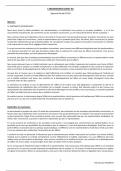Samenvatting
Samenvatting Innovatiemanagement RSM EUR BA2
- Instelling
- Erasmus Universiteit Rotterdam (EUR)
Samenvatting van alle benodigde stof voor het tentamen Innovatiemanagement in Blok 6 van jaar 2 (BA2) aan de Rotterdam School of Management (RSM).
[Meer zien]














